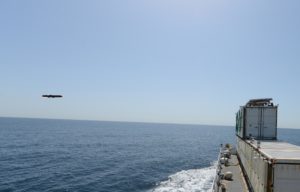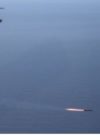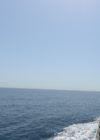Second trial success for MBDA’s Sea Venom/ANL missile

MBDA’s Sea Venom/ANL missile has successfully completed its second development firing from a French Defence Procurement Agency (DGA – Direction Générale de l’Armement) Panther test helicopter at Ile Du Levant in southeast France.
The firing, which took place on 18 April 2018, highlighted Sea Venom/ANL’s lock on after launch (LOAL) capabilities. It also validated its aptitude for low-altitude, sea-skimming flight, the effectiveness of the data link between the missile and helicopter and Sea Venom/ANL’s autonomous guidance capability, using images from its infrared seeker.
Guto Bebb, UK Minister for Defence Procurement, said:
“Sea Venom is yet another weapon that will help our Royal Navy keep the United Kingdom safe amid intensifying global threats. The lightweight subsonic sea-skimming missile, which will equip our Wildcat helicopters, will add to our Navy’s impressive capabilities while at sea and ensure they remain equipped to face every eventuality. The test firing partnership between France and the United Kingdom is also another fantastic display of the two nations working together to protect global waters.”
Frank Bastart, head of the Sea Venom/ANL programme at MBDA said:
“We’re delighted that the second development firing of Sea Venom/ANL was a complete success. We have now tested a range of the missile’s capabilities and it has performed to the very edge of its operational envelope, which is testament to the hard work and skills of our development and production teams in conjunction with DGA. This is a significant milestone in the development of the missile and when it enters service Sea Venom/ANL will provide a major increase in capability to the UK and French navies.”
Sea Venom/ANL is part of an Anglo-French programme linked to the Lancaster House treaty agreed between the UK and France in November 2010 and possesses a ‘fire and forget’ mode along with ‘operator above the loop’ capability to maintain control over the entire missile trajectory. It has been designed for use from the widest range of platforms; in UK service the missile will be used from the AW159 Wildcat helicopter, while France will operate the missile from its future Light Joint Helicopter (HIL – Hélicoptère Interarmées Léger). The missile is designed to enable the helicopters of both countries’ navies to deal with a range of threats including fast moving patrol boats, corvettes and coastal targets.
MBDA was awarded the production contract for Sea Venom/ANL in March 2014. The joint programme is the first to take full advantage of mutual dependency arrangements agreed under the ‘One Complex Weapons’ initiative designed to consolidate the Anglo-French missile industry around MBDA.

Le missile antinavire ANL/Sea Venom de MBDA a accompli avec succès son deuxième tir de développement à partir d’un hélicoptère banc d’essai de type Panther de DGA Essais en Vol sur une cible en mer, au large de l’île du Levant.
Le tir, qui a eu lieu le 18 Avril 2018, était un tir à longue portée avec vol du missile à très basse altitude et accrochage de la cible en milieu de course (Lock On After Launch – LOAL). Cet essai a également permis de valider l’aptitude du missile à la navigation au raz de l’eau (sea-skimming ), le bon fonctionnement de la liaison de données entre le missile et l’hélicoptère, ainsi que la capacité d’autoguidage de l’ANL/Sea Venom et ce grâce à l’utilisation d’images issues de son autodirecteur infrarouge.
Frank Bastart, chef du programme ANL/Sea Venom chez MBDA, déclare :
« Ce deuxième tir d’essai du missile ANL/Sea Venom a été une réussite totale. Nous avons pu valider plusieurs capacités du missile et ce, dans le cadre d’un scénario représentatif de son futur emploi. C’est le résultat du travail acharné de nos équipes de développement et de production, en collaboration étroite avec les équipes de la Direction générale de l’armement (DGA). Ceci est une étape très importante dans le développement du missile. Quand il entrera en service, il apportera une amélioration majeure aux capacités d’engagement des marines britannique et française. »
Le missile ANL/Sea Venom est issu d’une coopération franco-britannique qui s’inscrit dans le cadre du traité de Lancaster House signé par la France et le Royaume-Uni en novembre 2010. Il dispose du mode « tire et oublie » ainsi que de la capacité « homme dans la boucle » permettant de maîtriser le tir jusqu’à l’impact sur la cible. Le missile ANL/Sea Venom a été conçu pour une utilisation à partir d’une gamme diversifiée de plateformes. Au Royaume-Uni, le missile sera utilisé sur l’hélicoptère AW159 Wildcat de la Royal Navy tandis que la France l’utilisera sur les futurs Hélicoptères interarmées légers (HIL). Le missile ANL/Sea Venom permet de traiter un large panel de menaces de surface, depuis les vedettes rapides et manoeuvrantes jusqu’aux corvettes, y compris en environnement côtier.
Le contrat de réalisation du programme ANL/Sea Venom a été notifié à MBDA en mars 2014. Ce projet constitue le premier programme commun, qui tire pleinement parti des dispositions de dépendance mutuelle agréées dans le cadre de l’initiative « One Complex Weapons » visant à consolider l’industrie missilière franco-britannique autour de MBDA.
 Über dem französischen Mittelmeer-Testgelände Ile du Levant wurde der zweite Test, im Rahmen der Entwicklung, mit dem MBDA-Lenkflugkörpers Sea Venom/ANL erfolgreich abgeschlossen. Für den Testschuss wurde ein Panther-Hubschrauber der französischen Beschaffungsbehörde DGA (Direction Générale de l’Armement) eingesetzt.
Über dem französischen Mittelmeer-Testgelände Ile du Levant wurde der zweite Test, im Rahmen der Entwicklung, mit dem MBDA-Lenkflugkörpers Sea Venom/ANL erfolgreich abgeschlossen. Für den Testschuss wurde ein Panther-Hubschrauber der französischen Beschaffungsbehörde DGA (Direction Générale de l’Armement) eingesetzt.
Der Testabschuss vom 18. April 2018 hat die Lock-On-After-Launch (LOAL)-Fähigkeit von Sea Venom/ANL erfolgreich demonstriert. Im Rahmen des Versuchs wurde die Eignung des Sea Venom/ANL als dicht über der Wasseroberfläche fliegender Flugkörper, die Effektivität des Datenlinks und die Leistungsfähigkeit des Suchkopfes belegt.
Frank Bastart, Leiter des Sea Venom/ANL-Programms bei MBDA, sagte:
„Wir freuen uns, dass der zweite Testschuss von Sea Venom/ANL ein voller Erfolg war. Wir haben eine Reihe von Fähigkeiten des Flugkörpers getestet. Der Flugkörper hat eine optimale Leistung erbracht. Es ist das Ergebnis harter Arbeit und zeigt die Kompetenzen unserer Entwicklungs- und Produktionsteams in Zusammenarbeit mit der DGA. Dies ist ein wichtiger Meilenstein in der Entwicklung des Flugkörpers. Mit Inbetriebnahme wird Sea Venom/ANL die Fähigkeiten der britischen und der französischen Seestreitkräfte erheblich verbessern.”
Sea Venom/ANL wurde im Rahmen eines britisch-französischen Programms in Verbindung mit dem Lancaster-House-Abkommen zwischen Frankreich und Großbritannien von November 2010 entwickelt. Der Flugkörper besitzt einen „Fire-and-Forget“-Modus sowie eine „Operator-above-the-Loop“-Fähigkeit, um die Kontrolle über die gesamte Flugbahn zu behalten. Der Lenkflugkörper kann auf unterschiedlichen Plattformen eingesetzt werden: Großbritannien wird den Lenkflugkörper auf seinem Hubschrauber AW159 Wildcat und Frankreich auf den künftigen leichten Hubschraubern HIL (Hélicoptère Interarmées Léger) einsetzen. Der Lenkflugkörper wurde konzipiert, um es den Hubschraubern der Seestreitkräfte beider Länder zu ermöglichen, verschiedenste Bedrohungen, wie schnell fahrende Patrouillenboote, Korvetten und Küstenziele, abzufangen.
MBDA hat den Vertrag für die Produktion von Sea Venom/ANL im März 2014 erhalten. Es ist das erste gemeinsame Programm, das die Vorteile aus der gegenseitigen industriellen Abhängigkeit (mutual dependency) umfassend nutzt, die im Rahmen der „One Complex Weapons“-Initiative vereinbart wurde. Ziel dieser Initiative ist es, die britisch-französische Lenkflugkörperindustrie basierend auf MBDA zu stärken.
 Il missile Sea Venom/ANL di MBDA ha completato con successo il suo secondo lancio di sviluppo da un elicottero di prova Panther messo a disposizione dalla DGA francese (Direction Générale de l’Armement) presso il poligono di Ile Du Levant nel sudest della Francia.
Il missile Sea Venom/ANL di MBDA ha completato con successo il suo secondo lancio di sviluppo da un elicottero di prova Panther messo a disposizione dalla DGA francese (Direction Générale de l’Armement) presso il poligono di Ile Du Levant nel sudest della Francia.
Il lancio, avvenuto lo scorso 18 aprile, ha messo in evidenza le capacità LOAL (Lock On After Launch) aggancio dopo il lancio) del Sea Venom/ANL, convalidandone inoltre l’idoneità per l’impiego a bassa quota, il volo sea skimming, l’efficacia del data link tra missile ed elicottero e la capacità di guida autonoma, grazie al suo seeker a infrarossi.
Frank Bastart, responsabile del programma Sea Venom/ANL per MBDA, ha dichiarato:
“Siamo davvero felici che il secondo lancio di sviluppo del Sea Venom/ANL abbia avuto pieno successo. Abbiamo testato una serie di potenzialità del missile che ha dimostrato prestazioni all’estremo limite delle proprie capacità operative: tutto questo è stato possibile grazie al grande impegno ed alla professionalità dei nostri team di sviluppo e di produzione ed alla collaborazione con la DGA. Si tratta di una tappa significativa nello sviluppo del missile che, all’entrata in servizio, offrirà un importante incremento della capacità operativa alla marina britannica ed a quella francese”.
Il Sea Venom/ANL è parte di un programma anglo-francese legato al trattato di Lancaster House stipulato tra Regno Unito e Francia a novembre del 2010. Il missile è dotato di modalità “Fire and Forget”, insieme ad una capacità “operator-above-the-loop” per mantenere il controllo durante l’intera traiettoria del missile. È stato progettato per l’impiego su una gamma estremamente diversificata di piattaforme: nel Regno Unito il missile verrà utilizzato dall’elicottero AW159 Wildcat, mentre in Francia dal futuro HIL (Hélicoptère Interarmées Léger). Il missile è concepito per consentire agli elicotteri di entrambe le marine di affrontare vari tipi di minacce, incluse piccole imbarcaizoni veloci, corvette e obiettivi costieri.
MBDA si è aggiudicata il contratto di produzione per il Sea Venom/ANL nel marzo del 2014. Il programma congiunto è il primo a sfruttare pienamente gli accordi di reciproca dipendenza stipulati all’interno dell’iniziativa “One Complex Weapons” pensata per consolidare il settore missilistico anglo-francese intorno ad MBDA.





